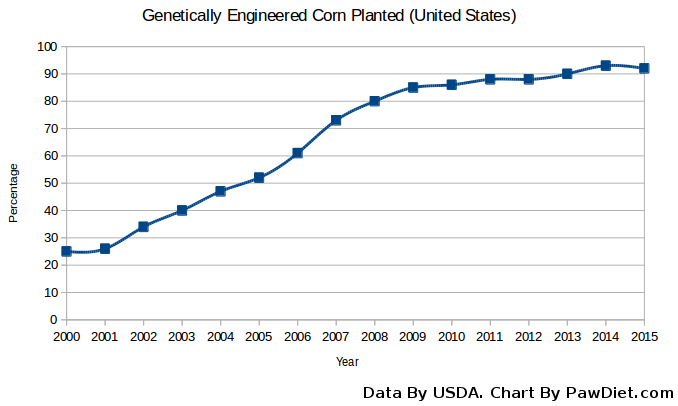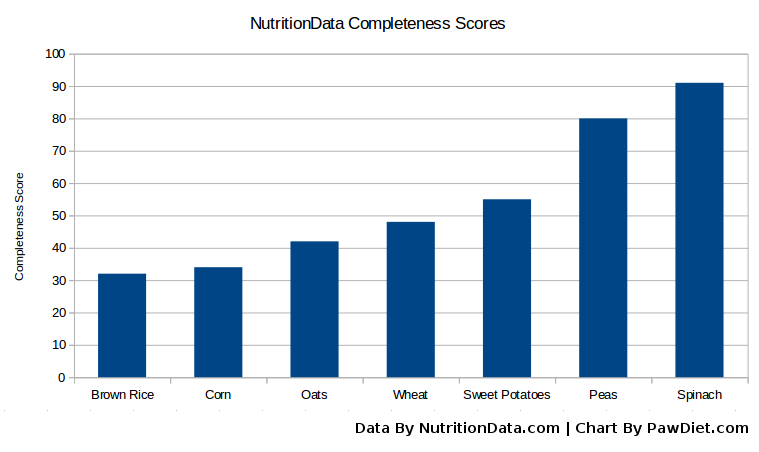Corn In Dog and Cat Food, A Truthful Discussion
Corn is one of the most controversial ingredients in pet food. While many dog food and cat food brands emphasize that their products do not contain corn, others boast about the nutritional benefits and attempt to justify the usage of corn.
In this article, we'll discuss both sides of the controversy and arrive at sensible conclusions based on facts. We'll begin with a general discussion on corn and then discuss corn in pet food.
Health Benefits of Corn
Corn (or maize) is a popular cereal grain which originated in Mexico. Roughly half the calories consumed by humans are supplied by corn, rice, and wheat. As with other cereal grains, corn is a major component of livestock feed and pet food.
Corn is predominately a source of carbohydrates, with a modest amount of protein and fat. Corn also contains a notable amount of dietary fiber. What's more interesting is that corn is naturally rich in many antioxidants which help repair and prevent cellular damage caused by free radicals.
Deducing from the numerous studies and the nutritional data from USDA, corn appears to be a nutritious ingredient for humans. However, the nutritional requirements of dogs and cats differ from that of humans.
The Biological Value and Usability of Protein
An important aspect to consider is the usability of corn protein. Humans and animals need amino acids to sustain life. The best source of amino acids are typically derived from animals.
For example, eggs are regarded as the “gold standard” of protein because they contain all essential amino acids in ideal proportions.
The usability of protein is often measured with the Biological Value (BV) metric. Eggs are often used as the official benchmark of BV, because of their superior composition.
Plant-based proteins typically yield a much lower biological value in comparison to animal-based protein. Therefore, protein from corn is not an appropriate substation for animal-based protein.
Pet food manufacturers often counter these statements by arguing that ingredients should not be studied in isolation. In other words, ingredients complement each other and the ideal amino acid proportions are achieved by the synergy among ingredients.
Products with corn often meet the AAFCO requirements, therefore we cannot disagree with the argument of ingredient synergy. However, we believe the biological appropriateness of the individual ingredients is also an important aspect to consider.
There are vegetarian diets which also satisfy AAFCO requirements. However, there are very few veterinarians and professionals that would be comfortable feeding cats (obligate carnivores) or dogs an entirely vegetarian diet.
Just because a product meets AAFCO requirements, which are human-made estimates, does not necessarily mean the product is healthy or biologically appropriate.
More Than 90% of Corn is Genetically Engineered

The vast majority of corn is planted in the United States. Data from USDA indicates that more than 90% of corn is genetically engineered. Nowadays, non-GMO corn is very difficult to find outside health conscious stores like Whole Foods Market and Trader Joe's. Given this information, it's safe to assume that corn in dog and cat food is genetically engineered.
According to PawDiet data, more than 20% of dog food and cat food contains corn. Of these products, the majority list corn within the first five ingredients. Because ingredients are listed on pet food labels by descending pre-cooked weight, it's safe to assume that corn makes up a significant portion of these products.
Genetically engineered ingredients are generally not considered harmful by the scientific community. However, there are many reputable organizations and experts which claim that the lack of solid long-term studies should warrant the removal of genetically engineered ingredients from the marketplace.
Our personal opinion is that opponents of genetically engineered ingredients raise valid arguments which cannot be ignored, therefore avoiding these ingredients would be a wise decision.
Adverse health affects can present themselves years after exposure, therefore short-term studies which have established the safety of genetically engineered ingredients is questionable.
The Digestibility of Corn
Corn is digestible to the extent in which it is processed. In order words, unprocessed whole grain corn is actually not digestible.
Any claim which states corn is highly digestible without clarifying the processing required is misleading consumers. Claims of high digestibility are one of the most common myths (or half-truths) associated with corn.
These type of claims are used to convince consumers that corn is biologically appropriate. However, the truth is that corn is only digestible when it has been ground into a flour or meal and subsequently cooked.
Nutritional Completeness of Corn
As we discussed earlier, corn does indeed provide many beneficial nutrients. However, the nutritional composition of corn does not justify it's usage as the primary ingredient in dog food and cat food.
In fact, when you compare the nutritional composition of corn to other plant based ingredients (e.g. spinach, sweet potatoes and oats), it becomes evident that corn is not the best thing since sliced bread.
The chart below displays the "Completeness Score" from NutritionData.com for various ingredients. The metric is computed by NutritionData using data from the USDA National Nutrient Database. As we can see, when compared to other common pet food ingredients, corn does not appear to be nutritionally superior.

Truth About Corn in Dog & Cat Food
In our opinion, corn is used as the primary ingredient in dog food and cat food because it is an inexpensive source of calories. Products which rely on corn are typically priced lower to target price sensitive customers, which is completely understandable.
Although dogs and cats can survive on corn based food, these products are not biologically appropriate. Large manufactures have spent millions of dollars to convince consumers that the usage of corn is justified, yet these justifications are half-truths and misinformation. In fact, manufactures which claim corn is an appropriate ingredient often own other brands which denounce corn.
Resources
- Joseph M. Awika.Soil & Crop Science Dept./Nutrition and Food Science Dept., Texas A&M University. Major Cereal Grains Production and Use around the World, Chapter 1
- MayoClinic. Dietary fiber: Essential for a healthy diet. Sept. 22, 2015
- Wikipedia. Biological Value. 4 May 2016
- Wikipedia. Maize. 23 April 2016
- United States Department of Agriculture National Agricultural Library
- NutritionData Completeness Score, nutritiondata.com.
* There are studies which support this claim, but the results are not conclusive.
